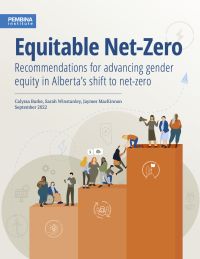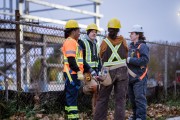International Women’s Day is a time to celebrate the achievements of women championing clean energy in Canada, but it should also be a time to take stock of the work still needed to achieve gender inclusion and diversity for all underrepresented groups in Canada’s new energy economy. The number of women working in the traditional energy industry remains low—in electricity, for example, only a quarter of workers are women—and early indications show that this trend is continuing in renewable energy industries.
Women are significantly underrepresented in many of the areas that will be affected as Canada builds out a low-carbon economy, including energy, natural resources, buildings and transportation.
Within these sectors, not only are women and gender diverse people underrepresented but they often occupy lower-paid jobs, increasing the gender pay gap, and contributing to six per cent of the overall gender pay gap in Canada. In Alberta where the oil and gas industry is most concentrated, women make a whopping 41 per cent less than men. That cannot be allowed to continue.
Now is the time for change
Public and private investments are beginning to pour into the new energy economy. Investments like those in the 2022 Fall Economic Statement and the Interim Sustainable Jobs Plan position Canada to invest significantly in clean energy and technology. If we don’t act quickly, apathy and indifference risk solidifying the same barriers in the new energy economy that have prevented women and other equity-deserving groups from fully participating in the traditional energy industry.
 According to our Equitable Net-Zero report, the major barriers women working in or trying to enter the energy industry face include a lack of access to opportunity, bias and a toxic industry culture that pushes women out. Our primary research and community engagement have shown that women in the energy sector have been told to ‘get used to’ sexual harassment and feelings of discomfort in the workplace because of the hypermasculine, ‘boys club’ culture that is deep rooted in this sector. These barriers together cause a systemic inability for women to advance and take on leadership roles, and result in a persistent gender pay gap.
According to our Equitable Net-Zero report, the major barriers women working in or trying to enter the energy industry face include a lack of access to opportunity, bias and a toxic industry culture that pushes women out. Our primary research and community engagement have shown that women in the energy sector have been told to ‘get used to’ sexual harassment and feelings of discomfort in the workplace because of the hypermasculine, ‘boys club’ culture that is deep rooted in this sector. These barriers together cause a systemic inability for women to advance and take on leadership roles, and result in a persistent gender pay gap.
A new and equitable energy economy
The new energy economy is projected to create significant opportunities to generate many well-paying, good jobs. But the opportunity cannot be fully realized if half of the population is unable to fully benefit from this new economy.
The shift towards low-carbon energy is an opportunity to begin to close the opportunity gap once and for all, while also ensuring our economy has a skilled and innovative workforce to continue to produce Canadian energy. More needs to be done from both a policy and culture perspective to remove the systemic barriers that prevent women from participating equitably in these essential industries.
We are advocating for government and industry to invest in policies that support women and gender diverse people in the energy workplace. These policies include better access to training and education opportunities for women; flexible and safe workplaces that ensure physical and mental health; supports for intersectional (intersecting and overlapping identities like gender, race, ethnicity, class, sexuality, religion, disability, etc.) gender-diverse leadership within companies and outside of them; and access to more detailed data that can be used transparently to track progress across all industries.
Culture eats EDI for breakfast
Paired with equal pay legislation and firm commitments from employers and shareholders to address equity, diversity and inclusion (EDI) barriers and issues, this must also be reinforced with a bottom-up approach that reshapes work cultures that perpetuate gender-based violence, harassment, and daily experiences of microaggressions and injustices.
As part of our primary research, we convened individuals representing industry, education, financial services, labour and government. Participants shared their own experiences of the barriers they faced personally or had seen others face in their careers.
There was wide consensus that workplace policy and culture is where change most urgently needs to occur. While inroads have been made, energy and energy-adjacent fields remain in environments that are often hostile to women, and that is a significant issue for both existing and prospective workers, including the next generation of women leaders.
Without plans in place to protect and retain marginalized employees, efforts being poured into pushing these groups into postsecondary STEM programs will fail when they enter into workplaces designed for people who do not look like them.
Investments must do double duty
The problems facing women in the energy industry might seem just as daunting as the problems facing our climate, but we know that real change is possible with real commitment. Through credible plans on climate and energy, technological innovation and low-carbon energy investments from both industry and government, we can make progress towards Canada’s net-zero emission by 2050 goals. We need that policy innovation and investment to do double duty by reaping the co-benefits of greater equity in Canada. And just like reducing the effects of climate change, we need it to happen, well, yesterday.









